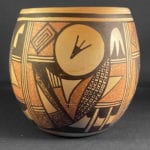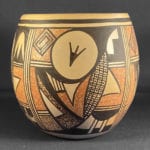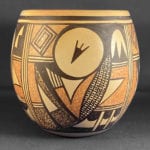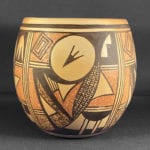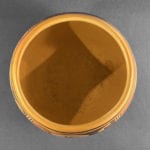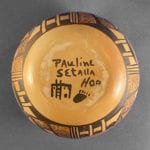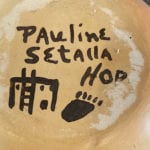This collection is particularly focused on Nampeyo and her descendants, thus the Nampeyo aesthetic is well represented. Jar 2018-12 is an interesting addition to this collection since it displays an attractive design that follows rules of beauty that are independent of the Nampeyo tradition.
This pot has an even graceful shape and moderately thick walls. It was outdoor fired with only slight blushing.
The decoration is in four panels separated by sets of our vertical lines, thus forming a three-lane “highway” between each section of design. All panels have a large unpainted circle with a black V-shaped element in the center, like a stylized three-toe animal foot print. Extending downward from the midpoint of the right side of the circle is an ear of corn with four rows of from 6 to 16 kernels, each containing a black dot. The corn reaches almost to the bottom of the panel.
To the left of the corn and extending to the upper left corner of the panel is a patchwork of Hopi/Tewa design elements. In the top corner of the panel, is a red stippled area surrounding a squared greek key formed by ten 90-degree angles. Below are three horizontal lines forming a two-lane “highway.” Below, along the border with the next panel is a vertical rectangle, wider at the bottom than the top. its center crossed another two-lane highway design. Above this element the rectangle is red, below speckled black.
Below the central circle and in the left center of the panel is a complex of designs formed around three different V-shaped elements that nestle together. The left most has a thick short base and a thinner vertical arm and is speckled black. It surrounds an unpainted triangle. To its right is a distorted black V twisted into the form of a backwards 7 with arms that are thicker at their juncture and thiner and curved as they extend out. Between these arms is the third V shape, again with slightly curved limbs. Two-thirds of this shape leans against the ear of corn and is speckled red; the remaining left end is is four black lines against an unpainted surface, The center of this last V is an unpainted triangle with somewhat curved sides.
The area to the right of the ear of the corn has yet to be discussed and this area has two variations that alternate around the jar, each presented twice. The top segment in version “a” has a black upper section with its center an unpainted area in the shape of an arch but with two black triangles intruding from the bottom. Below is the familiar two-lane highway, followed by a stippled red section, its center an unpainted right triangle. Below is another two-lane highway, followed by three stubby feathers with separate black gumdrop bases, their centers unpainted, followed by black rectangular tips.
The second version of this area to the right of the corn (version “b”) again has a black section in the top right corner, but at its center is an unpainted element that might be described as either a curved section intruded upon by the square corner of a rectangle or two irregular triangles with bases touching. Below is the familiar two lane highway. Next is a red speckled form similar to that in version “a” except that here the top side of the unpainted central triangle slopes sharply downward and the adjoining side is curved. Following is another two lane highway and three feathers of a different format. Their common base is a broad black half circle and then the familiar unpainted core followed by black tips.
Jar 2018-12 is signed on the bottom with Pauline Setalla’s name, the image of a pueblo dwelling with a ladder and a bear footprint indicating her clan. She was raised on the village of Mishongovi (Second Mesa) on the Hopi Reservation. Born in 1930, she married into the Frog Woman/Feather Woman families and learned pottery production techniques from her mother-in-law, Agnes Navasie, and her sister-in-law, Eunice Navasie. . Pauline had 10 children, many of them potters. Of these, Stetson Setalla, Dee Setalla, Gwen Setalla and Agnes Setalla are represented in this collection. (See Artist List.)


